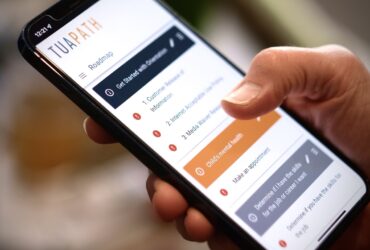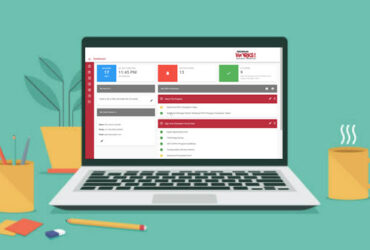Orientation: Leveraging What We Learned From The Pandemic
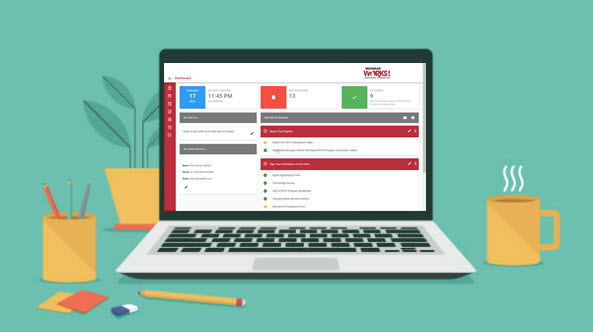

The past two years have certainly tested the ability of human services programs to adapt and persevere through crisis (COVID) in ways many people previously thought would not work given the low-income participants served. As we look ahead to what the “new normal” will look like, it’s critical that processes and support systems remain flexible in how services are delivered.
Orientation is one of those early processes that needs to be reimagined as we enter the post-pandemic recovery. We’re not talking about all the required forms that need to be filled out and signed (although those could be reduced) or the rules and requirements for completion, but the process. A time consuming and arduous process put squarely on the shoulders of participants that requires them to visit an office and spend hours filling out paperwork. It’s no wonder that forms are often incomplete or contain minimal information (one or two-word answers).

And from what we’ve heard, case managers haven’t necessarily been thrilled with in-person orientation in the past either, as group orientations mean there’s little time to spend with each participant to delve into the specifics of their situation.
What the pandemic showed us is that virtual orientations are a better fit all the way around. Virtual orientations allowed for more equitable access to services by removing the barriers of taking off from work, childcare or transportation. Meeting virtually provided case managers with the flexibility to meet participants when it made the most sense for them and they had time to talk. Talking with participants in the context of their family’s space often led to deeper conversations, more trust and more coaching.

Virtual orientations certainly have their benefits, and have proven to be effective in many cases, however, there remains the challenge of how best to support virtual or even online orientations. Zoom meetings are burdensome and time consuming for case managers to set-up and conduct and getting participants to show up for scheduled group meetings can be a real challenge.
Add to the fact, that in a virtual setting, how do you ensure that participants have the correct and required paperwork to review, complete and sign? Does the case manager email the information out to all participants or are they expected to download the forms from your website?
If they are emailing out forms, that’s just more time and effort piled on to the administrative burden they are already carrying. If participants are expected to grab forms from your website, how’s that going in terms of them finding the right forms?
There is a better solution!
Across Colorado and Michigan, numerous TANF agencies are using TuaPath to facilitate orientations entirely online. Using a computer, tablet or mobile phone, participants can …
- Watch videos to learn about the program and participation requirements and be quizzed afterwards to test comprehension.
- Fill out all the necessary paperwork and electronically sign acknowledgement or consent forms.
- Complete assessments or questionnaires to provide the full details regarding education, work history, and skills.
- Upload verification documentation from their mobile phones or computer.
- Access and download forms completed or documentation upload at any time for full transparency.
"95% of our participants are able to complete the orientation process using TuaPath with little to no help from staff."
Hillary Smigiel, Michigan Works! Southwest
All the steps to complete the orientation are clearly displayed on the participant’s dashboard and the status of completion denoted so participants can track their progress. At their own pace, participants can work on each task and if needed, after meeting with their case manager, go back and update any information provided.
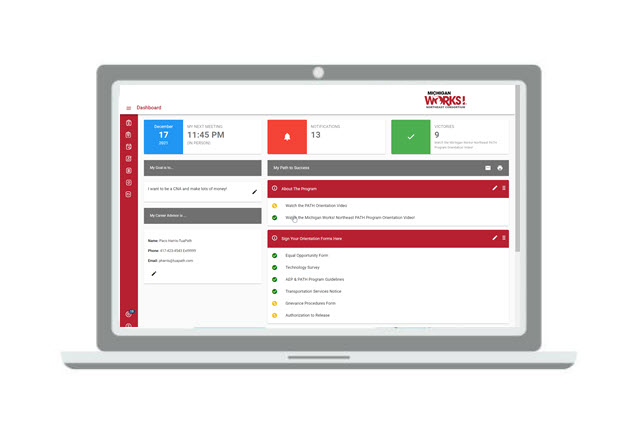
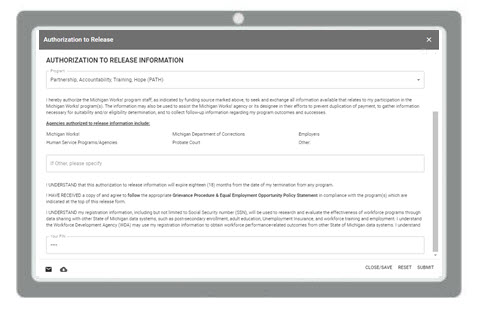
What the data shows and what we heard from case managers and participants using TuaPath is the following:
- TuaPath provides seamless and equitable access to service.
- 95% of participants can complete orientation with little to no help from staff.
- Those that are a bit more technology savvy appreciate being able to work independently and are able to complete the orientation process quickly. Those who struggle, get the extra time and help needed since case managers now have more capacity to do.
- Case managers can review all the information submitted during orientation, be better prepared for conversations that follow with participants.
- Having the assessments already completed and the forms signed translates into more time for motivational interviewing to help participants identify their goals and put forth a plan of action.
- For those feeling overwhelmed, case managers can assign, and participants can work on segments of the orientation, one at a time, and do not have to complete the entire process nor all the forms at once.
If needed, coaches could reset forms to allow participants to update their answers, resulting in more and better information provided.
"Having the entire orientation online allowed participants to complete the paperwork on their own time, at their own pace, which resulted in an abundance of information being shared like never before."
GST Michigan Works Coach
What we are witnessing in urban communities is TANF agencies are continuing to ask participants to complete orientation online and to meet and discuss action plans, virtually.
And while some rural TANF agencies are starting to encourage in-person orientations, they all plan to continue to use TuaPath to facilitate the process as it saves case managers time, reduces participant stress, supports full transparency as participants have access to all forms completed and documents uploaded, and both parties honestly prefer the online process.
So, if it’s a known fact that your orientation process is stressful and taxing for participants, and at the same time increases the administrative burden for case managers, it’s time to consider a new approach that improves outcomes.
Request a free consult. What do you have to lose?
